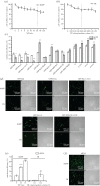Gene delivery ability of polyethylenimine and polyethylene glycol dual-functionalized nanographene oxide in 11 different cell lines
- PMID: 29134085
- PMCID: PMC5666268
- DOI: 10.1098/rsos.170822
Gene delivery ability of polyethylenimine and polyethylene glycol dual-functionalized nanographene oxide in 11 different cell lines
Abstract
We recently developed a polyethylenimine (PEI) and polyethylene glycol (PEG) dual-functionalized reduced graphene oxide (GO) (PEG-nrGO-PEI, RGPP) for high-efficient gene delivery in HepG2 and Hela cell lines. To evaluate the feasibility and applicability of RGPP as a gene delivery carrier, we here assessed the transfection efficiency of RGPP on gene plasmids and siRNA in 11 different cell lines. Commercial polyalkyleneimine cation transfection reagent (TR) was used as comparison. In HepG2 cells, RGPP exhibited much stronger delivery ability for siRNA and large size plasmids than TR. For green fluorescent protein (GFP) plasmid, RGPP showed about 47.1% of transfection efficiency in primary rabbit articular chondrocytes, and about 27% of transfection efficiency in both SH-SY5Y and A549 cell lines. RGPP exhibited about 37.2% of GFP plasmid transfection efficiency in EMT6 cells and about 26.0% of GFP plasmid transfection efficiency in LO2 cells, but induced about 33% of cytotoxicity in both cell lines. In 4T1 and H9C2 cell lines, RGPP had less than 10% of GFP plasmid transfection efficiency. Collectively, RGPP is a potential nano-carrier for high-efficiency gene delivery, and needs to be further optimized for different cell lines.
Keywords: gene delivery; graphene oxide; polyethylene glycol; polyethylenimine; transfection efficiency.
Conflict of interest statement
We declare we have no competing interests.
Figures





Similar articles
-
Hydrothermal Reduction of Polyethylenimine and Polyethylene Glycol Dual-Functionalized Nanographene Oxide for High-Efficiency Gene Delivery.ACS Appl Mater Interfaces. 2016 Nov 16;8(45):31311-31320. doi: 10.1021/acsami.6b09915. Epub 2016 Nov 4. ACS Appl Mater Interfaces. 2016. PMID: 27813400
-
In vitro assessments of nanoplexes of polyethylenimine-coated graphene oxide-plasmid through various cancer cell lines and primary mesenchymal stem cells.PLoS One. 2023 Dec 14;18(12):e0295822. doi: 10.1371/journal.pone.0295822. eCollection 2023. PLoS One. 2023. PMID: 38096179 Free PMC article.
-
Polyethylene glycol and polyethylenimine dual-functionalized nano-graphene oxide for photothermally enhanced gene delivery.Small. 2013 Jun 10;9(11):1989-97. doi: 10.1002/smll.201202538. Epub 2013 Jan 6. Small. 2013. PMID: 23292791
-
Polyethylene glycol and octa-arginine dual-functionalized nanographene oxide: an optimization for efficient nucleic acid delivery.Biomater Sci. 2018 May 29;6(6):1636-1650. doi: 10.1039/c8bm00058a. Biomater Sci. 2018. PMID: 29757340
-
Hepatocyte-targeted psiRNA delivery mediated by galactosylated poly(ethylene glycol)-graft-polyethylenimine in vitro.J Biomater Appl. 2011 Sep;26(3):255-75. doi: 10.1177/0885328210364678. Epub 2010 May 28. J Biomater Appl. 2011. PMID: 20511388
Cited by
-
The Role of MicroRNA 143 and MicroRNA 206 in The Regulation of Apoptosis in Mouse Lukemia Cancer Cells and Spermatogonial Cells.Cell J. 2021 Oct;23(5):544-551. doi: 10.22074/cellj.2021.7606. Epub 2021 Oct 30. Cell J. 2021. PMID: 34837682 Free PMC article.
-
Hydrophilic and Functionalized Nanographene Oxide Incorporated Faster Dissolving Megestrol Acetate.Molecules. 2021 Mar 31;26(7):1972. doi: 10.3390/molecules26071972. Molecules. 2021. PMID: 33807401 Free PMC article.
-
The Power of Three: Nanomaterials for Natural Killer (NK) Cell Immunoengineering Maximize Their Potency if They Exploit Multireceptor Stimulation.Adv Healthc Mater. 2024 Feb;13(5):e2302297. doi: 10.1002/adhm.202302297. Epub 2024 Jan 4. Adv Healthc Mater. 2024. PMID: 38029341 Free PMC article.
-
Niosome-Based Approach for In Situ Gene Delivery to Retina and Brain Cortex as Immune-Privileged Tissues.Pharmaceutics. 2020 Feb 25;12(3):198. doi: 10.3390/pharmaceutics12030198. Pharmaceutics. 2020. PMID: 32106545 Free PMC article. Review.
-
Functionalization and optimization-strategy of graphene oxide-based nanomaterials for gene and drug delivery.Am J Transl Res. 2020 May 15;12(5):1515-1534. eCollection 2020. Am J Transl Res. 2020. PMID: 32509159 Free PMC article. Review.
References
-
- Wong JK, Mohseni R, Hamidieh AA, Maclaren RE, Habib N, Seifalian AM. 2017. Will nanotechnology bring new hope for gene delivery? Trends Biotechnol. 35, 434–451. (doi:10.1016/j.tibtech.2016.12.009) - DOI - PubMed
-
- Mulligan RC. 1993. The basic science of gene therapy. Science 260, 926–932. (doi:10.1126/science.8493530) - DOI - PubMed
-
- Dyer MR, Herrling PL. 2000. Progress and potential for gene-based medicines. Mol. Ther. 1, 213–224. (doi:10.1006/mthe.2000.0044) - DOI - PubMed
-
- Onuki R, Nagasaki A, Kawasaki H, Baba T, Uyeda TQ, Taira K. 2002. Confirmation by FRET in individual living cells of the absence of significant amyloid β-mediated caspase 8 activation. Proc. Natl Acad. Sci. USA 99, 14 716–14 721. (doi:10.1073/pnas.232177599) - DOI - PMC - PubMed
-
- Takemoto K, Nagai T, Miyawaki A, Miura M. 2003. Spatio-temporal activation of caspase revealed by indicator that is insensitive to environmental effects. J. Cell Biol. 160, 235–243. (doi:10.1083/jcb.200207111) - DOI - PMC - PubMed
Associated data
LinkOut - more resources
Full Text Sources
Other Literature Sources
Research Materials

